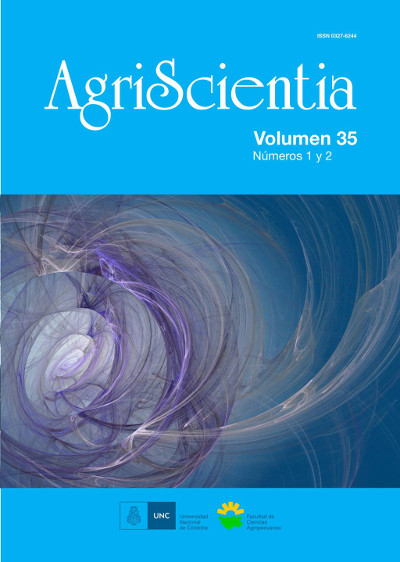Girdling efficiency and optimal cutting depth for the control of two invasive alien woody species in the Argentinian Chaco Serrano
Main Article Content
Abstract
Alien invasive woody species (AIWE) in mountain systems usually have high hydric demand and their rates of propagule production are generally elevated. The suppression of AIWE individuals through girdling should reduce propagule input, lowering their expansion rates and improving the conditions for native flora competition. The objective of this work was to evaluate the girdling efficiency and the optimal cutting depth over Morus alba L. and Melia azedarach L. mortality. With chainsaw, one or two girdles were made over the main stem in mature individuals of the mentioned species, and after two years, the survival and vigor of the treated individuals were evaluated. For both species the optimal cutting radio was defined through a percentage of the stem diameter: cutting critical threshold varied between 11 and 13 % of the stem diameter. These values assure for M. alba and M. azederach a treatment efficiency higher than 40 %. The single girdling is the most convenient treatment because of its efficiency and because it is cheaper than double girdling.
Downloads
Article Details
References
Améztegui, A., Aunós, A., y Serrano, L. (2009). El anillado como técnica de desvitalización de hayas en el Valle de Arán (Lleida). V Congreso Forestal Español, Ávila, España. 12 p.
Brassiolo, M. M., Gómez, C., Senilliani, M. G., y López, C. (2008). Mortalidad selectiva inducida para raleos en bosques nativos. Quebracho - Revista de Ciencias Forestales, 16, 94-101.
Cabrera, A. L. (1971). Fitogeografía de la República Argentina. Boletín de la Sociedad Argentina de Botánica, 14, 1-42.
De Schepper, V., van Dusschoten, D., Copini, P., Jahnke, S., y Steppe, K. (2012). MRI links stem water content to stem diameter variations in transpiring trees. Journal of Experimental Botany, 63(7), 2645-2653. DOI: 10.1093/jxb/err445.
Di Rienzo, J., Casanoves, F., González, L., Tablada, M., Robledo C., y Balzarini, M. (2017). Infostat. Software estadístico. Córdoba, Argentina. Facultad de Ciencias Agropecuarias, Universidad Nacional de Córdoba.
Efron, B. (1988). Logistic regression, survival analysis, and the Kaplan-Meier curve. Journal of the American Statistical Association, 83(402), 414-425.
Fleming, T. R., y Harrington, D. P. (1991). Counting processes and survival analysis. Nueva York, Estados Unidos: John Wiley y Sons, Inc.
Fredericksen, T., Contreras F., y Pariona, W. (2001). Guía de silvicultura para bosques tropicales de Bolivia. Santa Cruz, Bolivia: Proyecto BOLFOR.
Giorgis, M. A., Tecco, P. A., Cingolani, A. M., Renison, D., Marcora P., y Paiaro, V. (2011). Factors associated with woody alien species distribution in a newly invaded mountain system of central Argentina. Biological Invasions, 13(6), 1423-1434. DOI: 10.1007/s10530-010-9900-y.
Goodland, T. C. R., Healy J. R., y Binggeli, P. (1988). Control and management of invasive alien woody plants in the tropics. Publication Number 14, School of Agricultural and Forest Sciences, University of Wales.
Högberg, P., Nordgren, A., Buchmann, N., Taylor, A. F. S., Ekblad, A., Högberg, M. N., Nyberg, G., Ottosson-Lofvenius, M., y Read, D. J. (2001). Large-scale forest girdling shows that current photosynthesis drives soil respiration. Nature, 411, 789-792. DOI: 10.1038/35081058.
Jobbágy, E. G., Acosta, A. M., y Nosetto, M. D. (2013). Rendimiento hídrico en cuencas primarias bajo pastizales y plantaciones de pino de las sierras de Córdoba (Argentina). Ecología Austral, 23(2), 87-96.
Kleinbauer, I., Dullinger, S., Peterseil, J., y Essl, F. (2010). Climate change might drive the invasive tree Robinia pseudacacia into nature reserves and endangered habitats. Biological Conservation, 143(2), 382-390. DOI:10.1016/j.biocon.2009.10.024.
Loh, R. K., y Daehler, C. C. (2008). Influence of woody invader control methods and seed availability on native and invasive species establishment in a Hawaiian forest. Biological Invasions, 10(6), 805-819. DOI 10.1007/s10530-008-9237-y.
Melnyk, C. W., Schuster, C., Leyser, O., y Meyerowitz, E. M. (2015). A developmental framework for graft formation and vascular reconnection in Arabidopsis thaliana. Current Biology, 25(10), 1306-1318. DOI: 10.1016/j.cub.2015.03.032.
Mooney, H. A., y Hobbs, R. J. (2000). Invasive species in a changing world. Washington, DC., Estados Unidos: Island Press.
Pejchar L., y Mooney, H. A. (2009). Invasive species, ecosystem services and human well-being. Trends in Ecology & Evolution, 24(9), 497-504. DOI:10.1016/j.tree.2009.03.016.
Rejmánek, M., Richardson, D. M., y Pyšek, P. (2013). Plant invasions and invasibility of plant communities. En Van Maarel, E., y Franklin, J. (Eds.). Vegetation Ecology. Second Edition. Wiley, pp. 387-424.
Richardson, D. M., Holmes, P. M., Esler, K. J., Galatowitsch, S. M., Stromberg, J. C., Kirkman, S. P., Pyšek, P., y Hobbs, R. J. (2007). Riparian vegetation: degradation, alien plant invasions, and restoration prospects. Diversity and Distributions, 13(1), 126-139. DOI: 10.1111/j.1472-4642.2006.00314.x.
Schnitzler, A., Hale, B. W., y Alsum, E. M. (2007). Examining native and exotic species diversity in European riparian forests. Biological Conservation, 138(1), 146-156. DOI:10.1016/j.biocon.2007.04.010.
Tickner, D. P., Angold, P. G., Gurnell, A. M., y Mountford, J. O. (2001). Riparian plant invasions: hydrogeomorphological control and ecological impacts. Progress in Physical Geography, 25(1), 22-52.
Zeballos, S. R., Giorgis, M. A., Cingolani, A. M., Cabido, M., Whitworth Hulse, J. I., y Gurvich, D. E. (2014). Do alien and native tree species from Central Argentina differ in their water transport strategy? Austral Ecology, 39(8), 984-991. DOI:10.1111/aec.12171.

